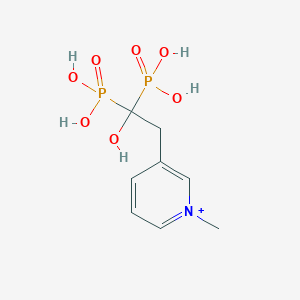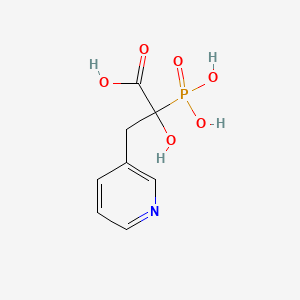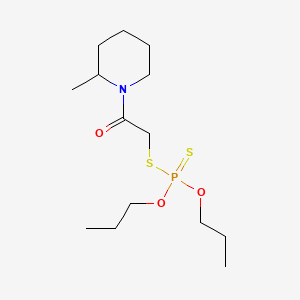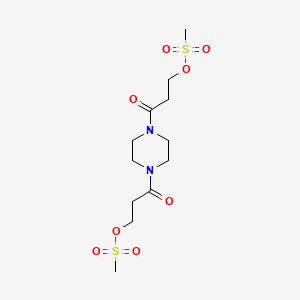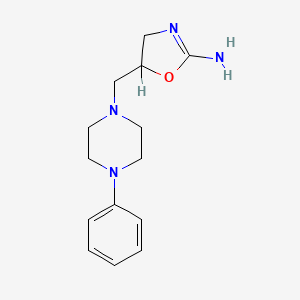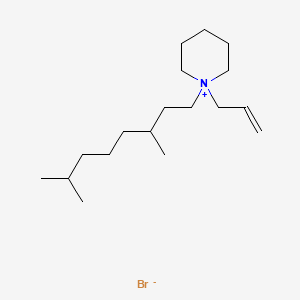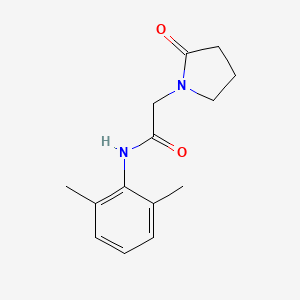
Nefiracetam
Descripción general
Descripción
Nefiracetam es un compuesto nootrópico que pertenece a la familia de las racetamas. Fue desarrollado por primera vez en Tokio en la década de 1990 por Daiichi Pharmaceutical. This compound es conocido por sus propiedades de mejora cognitiva, incluyendo mejoras en la memoria, el estado de ánimo y la motivación. Es un derivado del piracetam, con una estructura química similar pero con un grupo fenilo y dos grupos metilo añadidos a la amina, lo que aumenta su potencia en comparación con otras racetamas .
Aplicaciones Científicas De Investigación
Nefiracetam tiene una amplia gama de aplicaciones de investigación científica:
Química: Se utiliza como un compuesto modelo para estudiar derivados de racetam y sus propiedades químicas.
Biología: Se investiga por sus efectos en la señalización neuronal y la neuroprotección.
Medicina: Se estudia por su potencial en el tratamiento de deterioros cognitivos, enfermedad de Alzheimer y recuperación post-accidente cerebrovascular.
Industria: Se utiliza en el desarrollo de suplementos y productos farmacéuticos que mejoran la cognición
Mecanismo De Acción
Nefiracetam ejerce sus efectos a través de múltiples mecanismos:
Sistema GABAérgico: Mejora la señalización GABAérgica modulando los receptores GABA.
Sistema colinérgico: Aumenta los niveles de acetilcolina potenciando los receptores nicotínicos de acetilcolina.
Sistema monoaminérgico: Modula los neurotransmisores monoamina como la dopamina y la serotonina.
Canales de calcio: Actúa como un abridor de canales de calcio, facilitando la entrada de calcio y mejorando la plasticidad sináptica
Análisis Bioquímico
Biochemical Properties
Nefiracetam interacts with various enzymes, proteins, and other biomolecules. It shows high affinity for the GABA A receptor, where it is presumed to be an agonist . It enhances both GABAergic and cholinergic signalling . It also exhibits antiamnesic effects against a number of memory impairing substances .
Cellular Effects
This compound has significant effects on various types of cells and cellular processes. It influences cell function by enhancing signalling of acetylcholine and glutamate at the synapse and then prolonging the calcium in the activated neuron . It also modulates the GABAA receptor-channel, playing a significant role in reducing neuronal excitability throughout the nervous system .
Molecular Mechanism
This compound exerts its effects at the molecular level through several mechanisms. It prolongs the opening of calcium channels, which enhances signalling of a receptor independent of the synapse . It also augments signalling through cholinergic receptors, which then releases most excitatory neurotransmitters from the presynaptic level .
Temporal Effects in Laboratory Settings
In laboratory settings, the effects of this compound change over time. It does not appear to significantly affect memory formation acutely, but it can increase memory formation when taken daily over a prolonged period of time . It also shows a higher rate of neurogenesis with prolonged supplementation .
Dosage Effects in Animal Models
In animal models, the effects of this compound vary with different dosages. Animal studies using acute doses tend to note most benefits in the 3-10mg/kg range . This range has been repeatedly shown to enhance memory formation when taken daily over a prolonged period of time .
Metabolic Pathways
This compound is involved in various metabolic pathways. It is extensively metabolised, and its major metabolites in humans are 5-hydroxy-nefiracetam, 4-hydroxy-nefiracetam and N-[(2,6-dimethylphenylcarbamoyl)methyl]-succinamic acid .
Métodos De Preparación
Rutas sintéticas y condiciones de reacción: Nefiracetam se puede sintetizar a través de un proceso de varios pasos que involucra la reacción de 2,6-dimetilfenilamina con cloroacetato de etilo para formar un intermedio, que luego se cicla para producir this compound. Las condiciones de reacción generalmente implican el uso de solventes como etanol y catalizadores como etoxido de sodio .
Métodos de producción industrial: La producción industrial de this compound implica rutas sintéticas similares pero a mayor escala. El proceso se optimiza para obtener mayores rendimientos y pureza, a menudo involucrando pasos de purificación adicionales como recristalización y cromatografía para asegurar que el producto final cumpla con los estándares farmacéuticos .
Análisis De Reacciones Químicas
Tipos de reacciones: Nefiracetam experimenta varias reacciones químicas, incluyendo:
Oxidación: this compound se puede oxidar para formar derivados hidroxilados.
Reducción: Las reacciones de reducción pueden convertir this compound en su amina correspondiente.
Sustitución: this compound puede sufrir reacciones de sustitución nucleofílica, donde el grupo amina es reemplazado por otros nucleófilos.
Reactivos y condiciones comunes:
Oxidación: Los agentes oxidantes comunes incluyen permanganato de potasio y peróxido de hidrógeno.
Reducción: Se utilizan agentes reductores como hidruro de aluminio y litio y borohidruro de sodio.
Sustitución: Los nucleófilos como la azida de sodio y los tioles se emplean comúnmente.
Principales productos formados:
Oxidación: Derivados de this compound hidroxilados.
Reducción: Derivados de this compound aminados.
Sustitución: Varios compuestos de this compound sustituidos dependiendo del nucleófilo utilizado.
Comparación Con Compuestos Similares
Nefiracetam se compara con otras racetamas como:
Piracetam: La primera racetama, conocida por sus efectos de mejora cognitiva pero menos potente que el this compound.
Aniracetam: Similar al this compound pero con propiedades ansiolíticas adicionales.
Oxiracetam: Conocido por sus efectos estimulantes y mejora cognitiva.
Fenilpiracetam: Más potente que el piracetam, con propiedades estimulantes adicionales.
Pramiracetam: Altamente potente, utilizado principalmente para mejorar la memoria
This compound destaca por su combinación única de mejora cognitiva, neuroprotección y mejora del estado de ánimo, lo que lo convierte en un compuesto versátil en la familia de las racetamas.
Propiedades
IUPAC Name |
N-(2,6-dimethylphenyl)-2-(2-oxopyrrolidin-1-yl)acetamide | |
|---|---|---|
| Source | PubChem | |
| URL | https://pubchem.ncbi.nlm.nih.gov | |
| Description | Data deposited in or computed by PubChem | |
InChI |
InChI=1S/C14H18N2O2/c1-10-5-3-6-11(2)14(10)15-12(17)9-16-8-4-7-13(16)18/h3,5-6H,4,7-9H2,1-2H3,(H,15,17) | |
| Source | PubChem | |
| URL | https://pubchem.ncbi.nlm.nih.gov | |
| Description | Data deposited in or computed by PubChem | |
InChI Key |
NGHTXZCKLWZPGK-UHFFFAOYSA-N | |
| Source | PubChem | |
| URL | https://pubchem.ncbi.nlm.nih.gov | |
| Description | Data deposited in or computed by PubChem | |
Canonical SMILES |
CC1=C(C(=CC=C1)C)NC(=O)CN2CCCC2=O | |
| Source | PubChem | |
| URL | https://pubchem.ncbi.nlm.nih.gov | |
| Description | Data deposited in or computed by PubChem | |
Molecular Formula |
C14H18N2O2 | |
| Source | PubChem | |
| URL | https://pubchem.ncbi.nlm.nih.gov | |
| Description | Data deposited in or computed by PubChem | |
DSSTOX Substance ID |
DTXSID2020923 | |
| Record name | Nefiracetam | |
| Source | EPA DSSTox | |
| URL | https://comptox.epa.gov/dashboard/DTXSID2020923 | |
| Description | DSSTox provides a high quality public chemistry resource for supporting improved predictive toxicology. | |
Molecular Weight |
246.30 g/mol | |
| Source | PubChem | |
| URL | https://pubchem.ncbi.nlm.nih.gov | |
| Description | Data deposited in or computed by PubChem | |
CAS No. |
77191-36-7 | |
| Record name | Nefiracetam | |
| Source | CAS Common Chemistry | |
| URL | https://commonchemistry.cas.org/detail?cas_rn=77191-36-7 | |
| Description | CAS Common Chemistry is an open community resource for accessing chemical information. Nearly 500,000 chemical substances from CAS REGISTRY cover areas of community interest, including common and frequently regulated chemicals, and those relevant to high school and undergraduate chemistry classes. This chemical information, curated by our expert scientists, is provided in alignment with our mission as a division of the American Chemical Society. | |
| Explanation | The data from CAS Common Chemistry is provided under a CC-BY-NC 4.0 license, unless otherwise stated. | |
| Record name | Nefiracetam [INN] | |
| Source | ChemIDplus | |
| URL | https://pubchem.ncbi.nlm.nih.gov/substance/?source=chemidplus&sourceid=0077191367 | |
| Description | ChemIDplus is a free, web search system that provides access to the structure and nomenclature authority files used for the identification of chemical substances cited in National Library of Medicine (NLM) databases, including the TOXNET system. | |
| Record name | Nefiracetam | |
| Source | DrugBank | |
| URL | https://www.drugbank.ca/drugs/DB13082 | |
| Description | The DrugBank database is a unique bioinformatics and cheminformatics resource that combines detailed drug (i.e. chemical, pharmacological and pharmaceutical) data with comprehensive drug target (i.e. sequence, structure, and pathway) information. | |
| Explanation | Creative Common's Attribution-NonCommercial 4.0 International License (http://creativecommons.org/licenses/by-nc/4.0/legalcode) | |
| Record name | Nefiracetam | |
| Source | DTP/NCI | |
| URL | https://dtp.cancer.gov/dtpstandard/servlet/dwindex?searchtype=NSC&outputformat=html&searchlist=759830 | |
| Description | The NCI Development Therapeutics Program (DTP) provides services and resources to the academic and private-sector research communities worldwide to facilitate the discovery and development of new cancer therapeutic agents. | |
| Explanation | Unless otherwise indicated, all text within NCI products is free of copyright and may be reused without our permission. Credit the National Cancer Institute as the source. | |
| Record name | Nefiracetam | |
| Source | EPA DSSTox | |
| URL | https://comptox.epa.gov/dashboard/DTXSID2020923 | |
| Description | DSSTox provides a high quality public chemistry resource for supporting improved predictive toxicology. | |
| Record name | N-(2,6-dimethylphenyl)-2-(2-oxopyrrolidin-1-yl)acetamide | |
| Source | European Chemicals Agency (ECHA) | |
| URL | https://echa.europa.eu/information-on-chemicals | |
| Description | The European Chemicals Agency (ECHA) is an agency of the European Union which is the driving force among regulatory authorities in implementing the EU's groundbreaking chemicals legislation for the benefit of human health and the environment as well as for innovation and competitiveness. | |
| Explanation | Use of the information, documents and data from the ECHA website is subject to the terms and conditions of this Legal Notice, and subject to other binding limitations provided for under applicable law, the information, documents and data made available on the ECHA website may be reproduced, distributed and/or used, totally or in part, for non-commercial purposes provided that ECHA is acknowledged as the source: "Source: European Chemicals Agency, http://echa.europa.eu/". Such acknowledgement must be included in each copy of the material. ECHA permits and encourages organisations and individuals to create links to the ECHA website under the following cumulative conditions: Links can only be made to webpages that provide a link to the Legal Notice page. | |
| Record name | NEFIRACETAM | |
| Source | FDA Global Substance Registration System (GSRS) | |
| URL | https://gsrs.ncats.nih.gov/ginas/app/beta/substances/1JK12GX30N | |
| Description | The FDA Global Substance Registration System (GSRS) enables the efficient and accurate exchange of information on what substances are in regulated products. Instead of relying on names, which vary across regulatory domains, countries, and regions, the GSRS knowledge base makes it possible for substances to be defined by standardized, scientific descriptions. | |
| Explanation | Unless otherwise noted, the contents of the FDA website (www.fda.gov), both text and graphics, are not copyrighted. They are in the public domain and may be republished, reprinted and otherwise used freely by anyone without the need to obtain permission from FDA. Credit to the U.S. Food and Drug Administration as the source is appreciated but not required. | |
Synthesis routes and methods I
Procedure details








Synthesis routes and methods II
Procedure details







Synthesis routes and methods III
Procedure details







Retrosynthesis Analysis
AI-Powered Synthesis Planning: Our tool employs the Template_relevance Pistachio, Template_relevance Bkms_metabolic, Template_relevance Pistachio_ringbreaker, Template_relevance Reaxys, Template_relevance Reaxys_biocatalysis model, leveraging a vast database of chemical reactions to predict feasible synthetic routes.
One-Step Synthesis Focus: Specifically designed for one-step synthesis, it provides concise and direct routes for your target compounds, streamlining the synthesis process.
Accurate Predictions: Utilizing the extensive PISTACHIO, BKMS_METABOLIC, PISTACHIO_RINGBREAKER, REAXYS, REAXYS_BIOCATALYSIS database, our tool offers high-accuracy predictions, reflecting the latest in chemical research and data.
Strategy Settings
| Precursor scoring | Relevance Heuristic |
|---|---|
| Min. plausibility | 0.01 |
| Model | Template_relevance |
| Template Set | Pistachio/Bkms_metabolic/Pistachio_ringbreaker/Reaxys/Reaxys_biocatalysis |
| Top-N result to add to graph | 6 |
Feasible Synthetic Routes
Descargo de responsabilidad e información sobre productos de investigación in vitro
Tenga en cuenta que todos los artículos e información de productos presentados en BenchChem están destinados únicamente con fines informativos. Los productos disponibles para la compra en BenchChem están diseñados específicamente para estudios in vitro, que se realizan fuera de organismos vivos. Los estudios in vitro, derivados del término latino "in vidrio", involucran experimentos realizados en entornos de laboratorio controlados utilizando células o tejidos. Es importante tener en cuenta que estos productos no se clasifican como medicamentos y no han recibido la aprobación de la FDA para la prevención, tratamiento o cura de ninguna condición médica, dolencia o enfermedad. Debemos enfatizar que cualquier forma de introducción corporal de estos productos en humanos o animales está estrictamente prohibida por ley. Es esencial adherirse a estas pautas para garantizar el cumplimiento de los estándares legales y éticos en la investigación y experimentación.

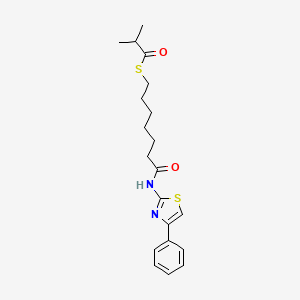
![4-[(3-bromobenzyl)amino]-4H-1,2,4-triazol-3-yl hydrosulfide](/img/structure/B1677937.png)
![(2S)-N-(2,3-dihydro-1H-inden-2-yl)-N-[(2-fluorophenyl)methyl]-2-[(1R)-1-naphthalen-1-yl-3,4-dihydro-1H-isoquinolin-2-yl]propanamide](/img/structure/B1677939.png)
